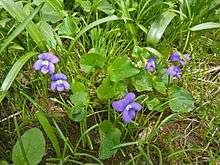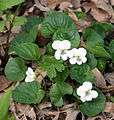Viola sororia
| Viola sororia | |
|---|---|
 | |
| Scientific classification | |
| Kingdom: | Plantae |
| (unranked): | Angiosperms |
| (unranked): | Eudicots |
| (unranked): | Rosids |
| Order: | Malpighiales |
| Family: | Violaceae |
| Genus: | Viola |
| Species: | V. sororia |
| Binomial name | |
| Viola sororia Wild. | |
| Synonyms[1] | |
| |
Viola sororia, known commonly as the common blue violet, is a stemless herbaceous perennial plant that is native to eastern North America. It is known by a number of common names, including common meadow violet, purple violet, the lesbian flower, woolly blue violet, hooded violet, and wood violet.
It is the state flower of Illinois, Rhode Island, New Jersey, and Wisconsin.
Self-seeding freely, in lawns and gardens it can become a weed. Cleistogamous seed heads may also appear on short stems in late summer and early autumn.
The common blue violet is also called the "lesbian flower" because in the early 1900s, lesbian women would give violets to the women they were wooing. This symbolized their "Sapphic" desire, so called because Sappho, a Greek lyric poet, in one of her poems described herself and her lover as wearing garlands of violets. This practice became popular in the 1910 – 1930 time period, and has become a substantial symbol for lesbian women in the modern era as well.
Uses
Beyond its use as a common lawn and garden plant, Viola sororia has historically been used for food and for medicine. The flowers and leaves are edible, and some sources suggest the roots can also be eaten. The Cherokee used it to treat colds and headaches. Rafinesque, in his Medical Flora, a Manual of the Medical Botany of the United States of North America (1828 – 1830), wrote of Viola sororia being used by his American contemporaries for coughs, sore throats, and constipation.
Gallery
 White flowering form
White flowering form V. sororia 'Freckles'
V. sororia 'Freckles'
References
| Wikimedia Commons has media related to Viola sororia. |
External links
- Viola sororia from the Connecticut Botanical Society
- Viola sororia from the Virginia Tech Weed Identification Guide
- 2003-04 Wisconsin Statutes & Annotations: 1.10 State song, state ballad, state waltz, state dance, and state symbols.
- USDA Plants Profile
- Duke, James. 1992. Handbook of Edible Weeds. CRC Press, Boca Raton, FL.
- Viola sororia: University of Wisconsin-La Crosse